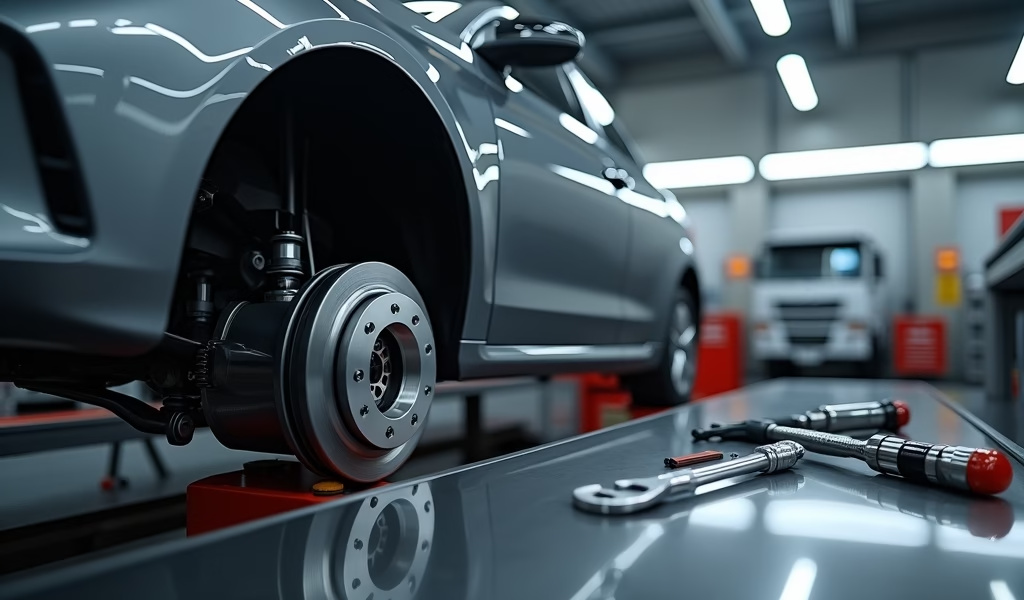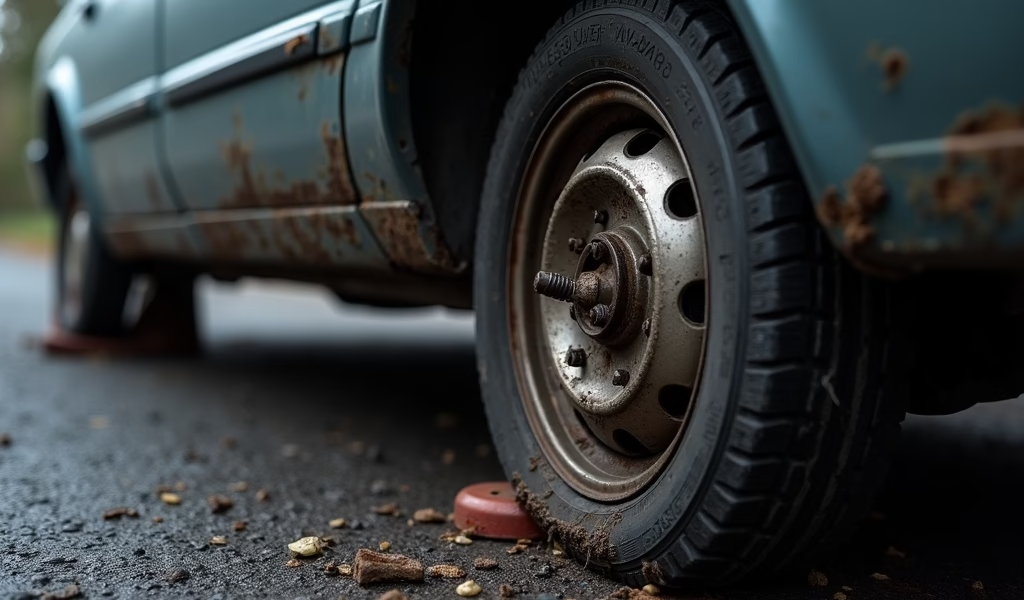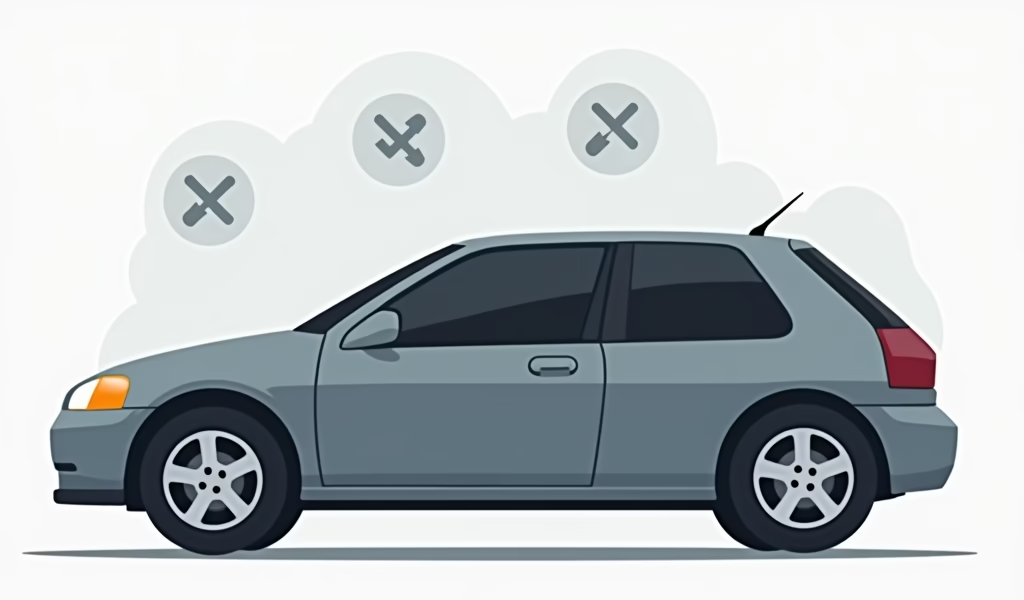Overview
This article provides expert guidance on front wheel hub bearing assemblies, covering recognition of failure symptoms, proper replacement techniques, quality part selection, and preventative maintenance practices. It emphasizes the importance of addressing bearing issues promptly to ensure vehicle safety, optimal performance, and cost savings while offering practical advice for both DIY enthusiasts and those seeking professional repairs.
Table of Contents
- Understanding the Front Wheel Hub Bearing Assembly
- Importance of Proper Maintenance
- Tip 1: Recognizing Symptoms of Failure
- Tip 2: Proper Replacement Techniques
- Tip 3: Selecting Quality Parts
- Tip 4: Preventative Maintenance Practices
- Cost Considerations
- Conclusion
- Frequently Asked Questions
Understanding the Front Wheel Hub Bearing Assembly
The front wheel hub bearing assembly is one of those critical components that most drivers don’t think about until something goes wrong. As a mechanic with over 15 years of experience, I’ve seen countless vehicles roll into my shop with issues that could have been prevented with a better understanding of this essential part.
So what exactly is this component? Simply put, the front wheel hub bearing assembly connects your wheel to the car’s suspension system. It’s responsible for supporting the vehicle’s weight while allowing the wheels to rotate smoothly with minimal friction. Think of it as the unsung hero that ensures your ride stays comfortable and your steering remains responsive.
The assembly consists of three main parts: the hub, which attaches to the wheel; the bearing, which allows for smooth rotation; and the mounting flange that connects to your vehicle’s suspension or steering knuckle. These parts work together as a sealed unit in most modern vehicles, unlike older models where bearings were serviceable separately.
When functioning properly, your front wheel hub bearing assembly supports smooth driving and efficient power transfer from your engine to the road. However, when issues arise, they can affect everything from handling to fuel economy.
Importance of Proper Maintenance
Maintaining your front wheel hub bearing assembly isn’t just about preventing annoying noises – though that’s certainly a benefit! It’s about ensuring your vehicle’s safety, performance, and longevity. These assemblies play a crucial role in your car’s handling characteristics and braking efficiency.
When hub bearings begin to fail, your vehicle’s stability becomes compromised. This can lead to unpredictable handling, especially during cornering or emergency maneuvers. According to a National Highway Traffic Safety Administration study, wheel-related failures contribute to a significant number of accidents each year.
Beyond safety concerns, properly maintained wheel bearings promote fuel efficiency. When bearings wear down, they create additional resistance that your engine must overcome, causing it to work harder and consume more fuel. One study from the Department of Energy showed that bad wheel bearings can reduce fuel economy by up to 2-3% – that adds up over time!
Perhaps most compelling is that regular inspection and maintenance of your front wheel hub bearing assembly can save you substantial money in the long run. Catching issues early typically means simpler, less expensive repairs. Wait too long, and you might face damage to related components like CV joints, brake rotors, or even your transmission.

Tip 1: Recognizing Symptoms of Failure
Your vehicle often speaks to you before major problems develop – you just need to know how to listen. When it comes to front wheel hub bearing assemblies, several telltale signs indicate potential issues. Catching these early can save you from costly repairs and dangerous driving conditions.
The most common symptom is noise – typically a humming, rumbling, or grinding sound that changes with vehicle speed. This noise often becomes more pronounced when turning in a specific direction. If you notice a sound that increases as you accelerate and isn’t affected by shifting gears, your wheel bearings should be high on the suspect list.
Another crucial indicator is unusual vibration or steering wheel shimmy. This might feel like driving over a rumble strip, even on smooth roads. The vibration typically worsens as your speed increases and can sometimes be accompanied by an unsettling floating sensation in the steering.
Pay attention to uneven tire wear as well. A failing hub bearing assembly can cause your wheel to wobble slightly, leading to irregular tire wear patterns. During your regular tire pressure checks, take a moment to examine the tread for unusual wear – it might save you from a bigger headache later.
More severe symptoms include a “clunking” noise when going over bumps or during cornering, and in extreme cases, excessive play or movement in the wheel when it’s jacked up and rocked by hand. If you notice any of these signs, don’t delay – have your vehicle inspected by a professional mechanic right away.
Common Symptoms Checklist:
- Humming, grinding, or rumbling noises that change with speed
- Noise that intensifies when turning
- Vibration in the steering wheel or floorboard
- Uneven or unusual tire wear patterns
- Steering feels loose or “floating”
- Clunking sounds over bumps or during turns
- ABS warning light illumination (in some vehicles)
Remember, modern vehicles have complex systems where symptoms can overlap. That clicking noise might not be a bearing but could indicate CV joint issues instead. That’s why proper diagnosis is essential before replacing parts.
Tip 2: Proper Replacement Techniques
Replacing a front wheel hub bearing assembly isn’t a job for everyone. While some DIY enthusiasts might tackle it in their garage, it requires specialized tools and technical know-how. Whether you’re doing it yourself or taking it to a shop, understanding the proper replacement process ensures the job is done right.
First and foremost, always work with the correct part. Vehicle-specific front wheel hub bearing assemblies are designed with precise tolerances for your make and model. Using the wrong part or attempting to mix and match components often leads to premature failure and safety issues. AAA recommends using OEM or equivalent quality parts for critical safety components like bearings.
The replacement process typically involves removing the wheel, brake caliper, and rotor to access the hub assembly. The hub is usually secured with bolts to the steering knuckle, and may require removing the axle nut (on drive wheels). Proper torque specification is absolutely critical here – over or under-tightening can lead to premature failure or unsafe conditions.
One common mistake is damaging the ABS sensor or wiring during replacement. Modern hub assemblies often incorporate ABS wheel speed sensors, and rough handling can break these sensitive components. Take care when disconnecting electrical connectors and avoid using excessive force.
Perhaps most important is cleanliness during installation. Even small particles of dirt or rust between mating surfaces can cause improper seating and lead to problems. Always clean mounting surfaces thoroughly and use the recommended lubricants when specified by the manufacturer.
Professional Replacement Steps:
- Secure the vehicle and remove the wheel
- Remove brake components (caliper, bracket, rotor)
- Disconnect ABS wiring if present
- Remove axle nut (if applicable) and hub retaining bolts
- Extract the old hub assembly without damaging other components
- Clean all mounting surfaces thoroughly
- Install the new assembly with proper alignment
- Torque all fasteners to manufacturer specifications
- Reconnect ABS wiring and verify proper connection
- Reinstall brake components and wheel
- Perform final inspection and road test
After replacement, a proper road test is essential. Listen for unusual noises and feel for vibrations or pulling. Sometimes, subtle issues only become apparent after driving for several miles, so don’t rush this step.
Tip 3: Selecting Quality Parts
Not all front wheel hub bearing assemblies are created equal. In my years turning wrenches, I’ve seen countless comeback repairs due to inferior parts. The difference between a quality hub assembly and a bargain option isn’t just about longevity – it affects safety, performance, and overall driving experience.
When selecting replacement parts, consider the manufacturer’s reputation. Established brands like Timken, SKF, and Moog have decades of engineering experience and rigorous quality control processes. These manufacturers supply original equipment to automakers and maintain the same standards for their aftermarket parts.
Material quality makes a tremendous difference in bearing performance. Premium hub assemblies use high-grade steel with precise heat treatment for optimal hardness and durability. The bearing races (the surfaces where the balls or rollers move) should have consistent finishing without any visible imperfections.
Another critical factor is the quality of seals. The bearing seals keep lubricant in and contaminants out – when they fail, the bearing fails. Premium assemblies use multi-lip seals with superior materials that maintain flexibility and sealing properties across extreme temperatures.
While price shouldn’t be your only consideration, be wary of hub assemblies that seem too inexpensive. The old adage “you get what you pay for” certainly applies here. That $40 hub assembly might seem like a bargain compared to the $120 premium option, but not when you’re replacing it again in 10,000 miles – or worse, dealing with a failure on the highway.

Tip 4: Preventative Maintenance Practices
An ounce of prevention is worth a pound of cure, especially when it comes to your front wheel hub bearing assembly. While modern hub assemblies are sealed units that don’t require lubrication service, there are still several preventative measures you can take to maximize their lifespan.
Regular inspection should be part of your vehicle maintenance routine. During tire rotations (typically every 5,000-7,000 miles), have your mechanic check for play in the wheel bearings. They can perform this quick check by gripping the tire at the 12 and 6 o’clock positions and rocking the wheel while it’s off the ground. Excessive movement indicates potential problems.
Driving habits significantly impact bearing life. Harsh impacts from potholes, curbs, and speed bumps can damage the precision components inside the hub assembly. Navigating these obstacles carefully not only protects your bearings but also your suspension and alignment.
Exposure to water and contaminants can accelerate wear. If you frequently drive through deep water, mud, or salt (during winter months), consider more frequent inspections. According to research from SAE International, road salt exposure can reduce bearing life by up to 40% if seals become compromised.
Pay attention to your wheels and tires too. Proper tire inflation and regular balancing reduce stress on the bearings. Unbalanced wheels create vibration that, over thousands of miles, can cause premature bearing wear. Similarly, proper alignment ensures even load distribution across the bearings.
Preventative Maintenance Schedule:
- Inspect for play and noise every 5,000-7,000 miles (during tire rotations)
- Check for unusual tire wear patterns that might indicate bearing issues
- Have wheels balanced every 12,000-15,000 miles
- Maintain proper alignment according to manufacturer specifications
- Keep tires properly inflated – check monthly
- Thoroughly clean wheels and surrounding areas after exposure to salt or corrosive materials
- Address any unusual noises or vibrations promptly
Remember that prevention extends beyond just the bearings themselves. Keeping your vehicle’s suspension in good condition reduces stress on all components, including wheel bearings. Regular inspection of related parts like control arms, struts, and bushings can help identify issues before they affect your hub assemblies.
Cost Considerations
Let’s talk dollars and cents – because understanding the financial aspect of front wheel hub bearing assembly replacement helps you make informed decisions. The costs vary widely based on your vehicle make, model, and whether you choose professional installation or DIY.
For parts alone, expect to pay anywhere from $40 to $400+ per hub assembly. Economy cars typically fall on the lower end of that spectrum, while luxury vehicles and large trucks often require more expensive components. As mentioned earlier, quality matters – opting for premium parts usually means spending in the $100-200 range for most mainstream vehicles.
Labor costs for professional installation typically range from $150 to $400 per side, depending on your location and the complexity of your vehicle. Some hub assemblies require minimal disassembly, while others might necessitate removing substantial suspension components, increasing labor time and cost.
If you’re considering the DIY approach, factor in the cost of tools. You’ll likely need a torque wrench, socket set, hub puller (for some vehicles), and possibly a press for older-style bearings. For occasional use, renting specialized tools from auto parts stores is often more economical than purchasing them outright.
It’s also worth considering the cost of related services. While the hub is being replaced, it’s an ideal time to inspect brake components, suspension parts, and CV joints. Addressing multiple issues during a single repair session can save on labor costs compared to separate visits.
Average Cost Breakdown:
- Economy/Compact Car: $200-350 per side (parts and labor)
- Mid-size Car/Small SUV: $300-450 per side
- Luxury Vehicle/Large SUV: $400-700+ per side
- DIY Parts Only: $40-400 per assembly (quality dependent)
- Professional Labor: $150-400 per side
Remember that timely replacement often prevents additional expenses. A severely worn bearing that fails completely can damage other components like CV joints, brake rotors, or even cause wheel separation in extreme cases. The relatively modest cost of proactive replacement pales in comparison to these potential consequences.
Conclusion
Your front wheel hub bearing assembly may not be the most glamorous part of your vehicle, but it’s certainly among the most crucial for safety and performance. By understanding the symptoms of failure, investing in quality parts, following proper replacement procedures, and implementing preventative maintenance, you can ensure these critical components provide reliable service throughout your vehicle’s life.
Remember that unusual noises, vibrations, or handling issues should never be ignored. These early warning signs give you the opportunity to address problems before they escalate into dangerous failures or cause collateral damage to other expensive components.
Whether you’re a DIY enthusiast with the tools and know-how to tackle replacement yourself, or you prefer to trust a professional mechanic, having knowledge about your front wheel hub bearing assembly empowers you to make informed decisions about your vehicle’s maintenance.
The next time you’re enjoying that smooth, quiet ride in your vehicle, spare a thought for those hardworking bearings that make it possible. With proper care and attention, they’ll continue to serve you faithfully for many miles to come.
Frequently Asked Questions
How long do front wheel hub bearing assemblies typically last?
Most quality hub bearings last between 85,000 to 100,000 miles under normal driving conditions. However, this can vary based on driving habits, road conditions, and the quality of the parts installed.
Can I drive with a bad wheel bearing?
It’s not recommended to drive with a bad wheel bearing as it can lead to unpredictable handling and potentially catastrophic failure. A compromised bearing can eventually seize or separate, causing loss of control.
How long does it take to replace a front wheel hub bearing assembly?
A professional mechanic typically needs 1-2 hours per side to replace a hub assembly. DIY replacement may take 2-4 hours for those with moderate mechanical experience.
Can wheel bearings fail without making noise?
Yes, though it’s uncommon, bearings can deteriorate without producing obvious noise. Regular inspection during tire rotations helps catch silent failures through detection of wheel play or uneven tire wear.
Should I replace both front wheel bearings at the same time?
While not strictly necessary, replacing both sides simultaneously is often recommended if the vehicle has high mileage. This provides balanced performance and eliminates the need for a second service visit when the other side inevitably fails.

